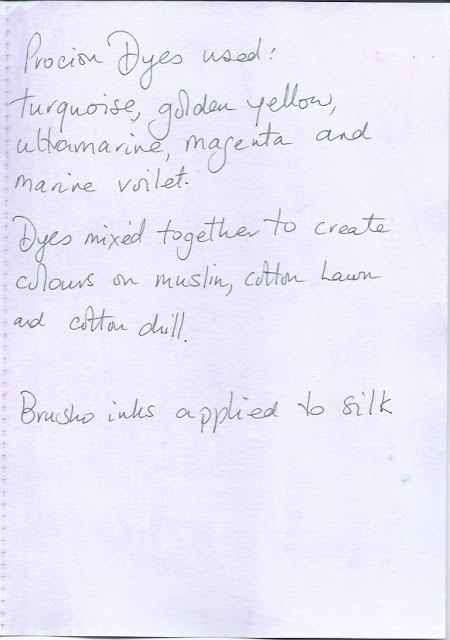I chose 3 pictures to work from, a sea fan coral, an army of sea urchins and the spiral of a sea snail's shell. All the embroideries measure approximately 15cm x 15cm.
 |
| Page 94 |
I chose this picture because I liked the intricacy of the pattern and the graduation of colours. I decided to layer hand stitch over machine embroidery. To emphasise the stronger branches of the sea fan, I created a separate piece of machine embroidery on soluble fabric, graduating the blend of colours through the veins.
 |
| Page 95 |
I looked for a pattern in the picture that would provide movement and flow. I drew my design on tracing paper.
 |
| Page 96 |
On a second piece of tracing paper I added the branching stems/veins of the fan coral.
 |
| Page 97 |
Using one of my dyed cotton drill pieces, I machine stitched the shapes onto the fabric.
 |
| Page 98 |
I overstitched with a variety of chain stitches in different sizes, changing the colour of my thread to match the colour of the fabric. Small pieces of gold fabric have been trapped under the hand stitching.
I used Supermend powder to stick them down, but it wasn't very successful and quite a few snippets drifted away!
 |
| Page 99 |
I created the stem on soluble fabric, following instructions in
Meredith Woolnough's book, called Organic Embroidery. I used 2 shades of purple, light and dark, to create it. Although it is not too clear, the central part of the stem is lighter than the tips. I laid it onto my embroidery but felt that the stem stood too proud against the background.
 |
| Page 100 |
To soften things down, I laid a piece of black tuile over the piece and machine stitched more branches/veins into the embroidery. I edged the embroidery with cable zigzag.
 |
| Page 100a |
I removed the black net and the dominant outline and restitched the branches in cable chain in darker threads, much better!
 |
| Page 100b |
Close up of reworked embroidery.
 |
| Page 101 |
My second source of inspiration was this picture of sea urchins, which live on coral reefs and help to maintain the balance between coral and algae.
 |
| Page 102 |
I looked for shapes within the picture and drew my first design onto tracing paper.
 |
| Page 103 |
On a second layer of tracing paper I drew the spines. The design has become more abstract than the sea fan coral design.
 |
| Page 104 |
I created a background on dyed cotton lawn by placing torn pieces of Bondaweb and snippets of threads together. I marked the circles on the fabric with a frixion pen and then arranged the darker pieces in the circles with the lighter snippets surrounding them. I then sprinkled the fabric with Supermend, laid a piece of black tuile over the top and ironed everything together.
 |
| Page 105 |
I machine stitched around the circles several times. Next I zigzagged round inside each circle. Then I added the spikes with long straight machine stitching. Afterwards I chose blanket stitch to emphasise the spikes. The machine and hand stitched spikes all intertwine to create an impression of sharpness and aggression.
 |
| Page 106 |
Close up.
I have added tufted 'urchins' to bring more texture to the stitching.
 |
| Page 107 |
Looking for a softer, more gentle source of inspiration, I chose a simple spiral.
 |
| Page 108 |
As before I traced the design onto tracing paper, to help me build up the layers.
I added another layer of more exaggerated shapes on a second piece of tracing paper.
 |
| Page 109 |
I started machine zigzagging from the outside to the centre using the settings of 3, 5 and 7 for the stitch width.
 |
| Page 110 |
Over the zigzag stitch, I added rows of cable stitch and a raised layer of zigzag stitch with the help of my fringe foot.
 |
| Page 111 |
 |
| Page 112a |
A few simple shapes, on a soft blue and pink background.
 |
| Page 112b |
Hand stitching over machine stitch in pale blue thread and metallic, variegated pink thread.
 |
| Presentation Board for Chapter 7 |








































































